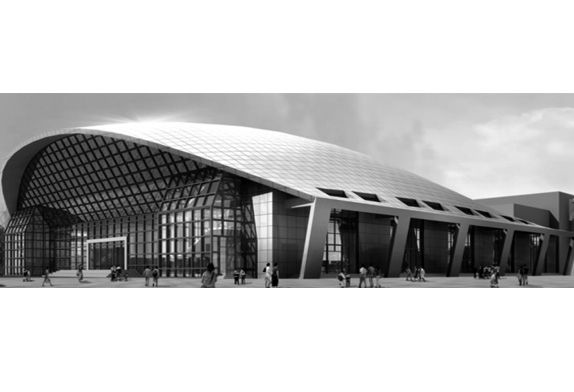1 Project Overview
The pavilion of the Youth Activity Center is 50m long from north to south and 67.8m long from east to west. There are a 28mx15m dolphin performance pool and three temporary dolphin feeding pools. The main roof structure is a steel space frame structure. The projected area of the space frame is 3275m², and the project effect is shown in Figure 1.

Picture 1 Youth Activity Center
The space structure is a space frame structure with many rods and a large exposed surface area. When the corrosion of a steel structure has a great impact on its quality, safety, and durability, effective anti-corrosion design can improve the durability of steel structure and prolong the service life of steel structure, so it is very important to carry out anti-corrosion design in the space frame structure. Based on the analysis of the corrosion mechanism and common anti-corrosion methods of steel structure, combined with the characteristics of the space frame structure, the anti-corrosion design scheme of the steel structure is determined. The relevant results can provide a reference for the anti-corrosion design of similar steel structures.
2 Determination of corrosion mechanism and anti-corrosion method of steel structure
2.1 Corrosion mechanism of steel structure
Corrosion refers to (including metal and non-metal) in the surrounding medium (water, air, acid, alkali, salt, solvent, etc.) under the action of loss and damage process. The corrosion of building steel structures is mainly affected by atmospheric corrosion, that is, steel is affected by oxygen and water in the atmosphere, resulting in the electrochemical process of corrosion.
2.2 Analysis of anti-corrosion technology
2.2.1 Use of Weathering steel refers to a kind of atmospheric corrosion-resistant steel made by adding various alloy elements. Under the action of the atmosphere, a dense anti-corrosion film can be formed automatically on the surface of the steel, thus playing an anti-corrosion role. This method is often used in railways, bridges, locomotives, drilling towers, and other steel structures exposed to the atmosphere for a long time. Although weathering steel has better corrosion resistance, the price of weathering steel is more expensive. Aluminized steel has good corrosion resistance to fresh water and sea water and is widely used in electronic transport towers in the open air.
2.2.2 Anti-corrosion of hot-dip aluminum composite coating
The hot aluminum composite coating is through the surface of the steel component sandblasting derusting so that its surface is exposed to metal luster and hair, and then the aluminum is heated, the molten particles atomized, sprayed to the surface of the base material, and finally using epoxy resin and other coatings to fill the pores, forming a composite coating. However, the construction process of hot aluminum composite coating is various, which affects the processing period of steel structure.
2.2.3 Hot dip galvanizing and anti-corrosion
Hot-dip galvanized anti-corrosion is to immerse the steel member after rust removal into the zinc solution melted at a high temperature of about 600℃ so that the surface of the steel member is attached to the zinc layer, so as to achieve the purpose of anti-corrosion. This method has the advantage of durable life of long, production of a high degree of industrialization, and stable quality, and therefore is widely used in atmospheric corrosion is serious and difficult maintenance of outdoor steel structures, however, the technology has certain objective restrictions, hot dip galvanized steel structure corrosion is mainly suitable for small parts, and must be carried out within the designated factory.
2.2.4 Coating method for anti-corrosion
The coating method anti-corrosion is to prevent or isolate corrosive medium namely water and air from contacting the steel surface by spraying one or more layers of paint on the surface of the steel structure, so as to achieve the purpose of protecting steel. With the development of anti-corrosion technology and materials, paint anti-corrosion can also reach more than 15 years of service life. Although the coating method is not as anti-corrosive as the long-acting anti-corrosion method, it has a series of advantages such as a simple process, low cost, wide selection range, and strong applicability, so it is used for indoor steel structures or outdoor steel structures that are relatively easy to maintain.
2.3 Determination of anti-corrosion methods
The above variety of anti-corrosion methods, weathering steel (such as aluminized steel), hot aluminum plating, and hot galvanizing anti-corrosion greatly increase the project cost, increase the processing period, the installation of most of the rods need to be assembled on-site, easy to damage the galvanized coating, high repair cost. Mainly for economic reasons, considering that the roof space frame of this project is located on the concrete main structure, and there is a through horse path above the space frame, which can organize regular maintenance within the service life, so it is determined that this project adopts the coating method for anti-corrosion.
The building effect of the youth activity centers is high, and the anti-corrosion of the steel structures is particularly important. In this paper, through the analysis of steel structure anti-corrosion technology, comparative analysis of weathering steel, hot aluminum plating composite coating, hot galvanizing and coating method anti-corrosion technology on the overall appearance of the structure, engineering cost, construction, and other aspects, determine the project to use coating method anti-corrosion technology.











 About Us
About Us 2022-11-04
2022-11-04


